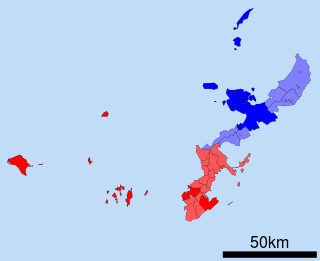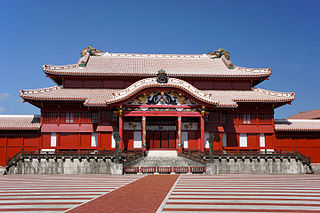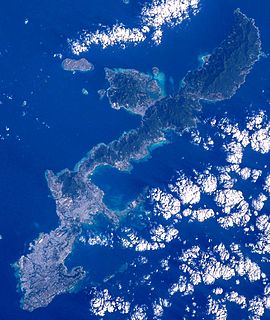
Okinawa Prefecture is a prefecture of Japan located on the Ryukyu Islands. Okinawa Prefecture has a population of 1,457,162 and has a geographic area of 2,281 km².

The Ryukyuan people, also Lewchewan or Loochooan, are an East Asian ethnic group native to the Ryukyu Islands between the islands of Kyushu and Taiwan. Politically, they live in either Okinawa Prefecture or Kagoshima Prefecture. Their languages make up the Ryukyuan languages, considered to be one of the two branches of the Japonic language family, the other being Japanese and its dialects. Hachijō is sometimes considered to be the third branch.

The Okinawan language or Central Okinawan, is a Northern Ryukyuan language spoken primarily in the southern half of the island of Okinawa, as well as in the surrounding islands of Kerama, Kumejima, Tonaki, Aguni and a number of smaller peripheral islands. Central Okinawan distinguishes itself from the speech of Northern Okinawa, which is classified independently as the Kunigami language. Both languages are listed by UNESCO as endangered.

The Japanese diaspora, and its individual members known as nikkei (日系) or as nikkeijin (日系人), comprise the Japanese emigrants from Japan residing in a country outside Japan. Emigration from Japan was recorded as early as the 15th century to the Philippines, but did not become a mass phenomenon until the Meiji period (1868-1912), when Japanese emigrated to the Philippines and to the Americas. There was significant emigration to the territories of the Empire of Japan during the period of Japanese colonial expansion (1875-1945); however, most of these emigrants repatriated to Japan after the 1945 surrender of Japan ended World War II in Asia.

The Ryukyuan languages, also Lewchewan languages, are the indigenous languages of the Ryukyu Islands, the southernmost part of the Japanese archipelago. Along with the Japanese language, they make up the Japonic language family. The languages are not mutually intelligible with each other. It is not known how many speakers of these languages remain, but language shift towards the use of Standard Japanese and dialects like Okinawan Japanese has resulted in these languages becoming endangered; UNESCO labels four of the languages "definitely endangered" and two others "severely endangered".

This article is about the history of the Ryukyu Islands southwest of the main islands of Japan.

The Ryukyu Kingdom was a kingdom in the Ryukyu Islands from 1429 to 1879.

Okinawa Island is the largest of the Okinawa Islands and the Ryukyu (Nansei) Islands of Japan in the Kyushu region. It is the smallest and least populated of the five main islands of Japan. The island is approximately 106 kilometres (66 mi) long, an average 11 kilometres (7 mi) wide, and has an area of 1,206.98 square kilometers (466.02 sq mi). It is roughly 640 kilometres (400 mi) south of the main island of Kyushu and the rest of Japan. It is 500 km (300 mi) north of Taiwan. The total population of Okinawa Island is 1,384,762. The Greater Naha area has roughly 800,000 residents, while the city itself has about 320,000 people. Naha is the seat of Okinawa Prefecture on the southwestern part of Okinawa Island. Okinawa has a humid subtropical climate.

The Yaeyama language is a Southern Ryukyuan language spoken in the Yaeyama Islands, the southernmost inhabited island group in Japan, with a combined population of about 53,000. The Yaeyama Islands are situated in the Southern Ryukyu Islands, southwest of the Miyako Islands and to the east of Taiwan. Yaeyama (Yaimamunii) is most closely related to Miyako. The number of competent native speakers is not known; as a consequence of Japanese language policy which refers to the language as the Yaeyama dialect, reflected in the education system, people below the age of 60 tend to not use the language except in songs and rituals, and the younger generation exclusively uses Japanese as their first language. As compared to the Japanese kokugo, or Japanese national language, other Ryukyuan languages such as Okinawan and Amami have also been referred to as dialects of Japanese. Yaeyama is noted as having a comparatively lower "language vitality" among neighboring Ryukyuan languages.

The Amami Islands is an archipelago in the Satsunan Islands, which is part of the Ryukyu Islands, and is southwest of Kyushu. Administratively, the group belongs to Kagoshima Prefecture, Japan. The Geospatial Information Authority of Japan and the Japan Coast Guard agreed on February 15, 2010, to use the name of Amami-guntō (奄美群島) for the Amami Islands. Prior to that, Amami-shotō (奄美諸島) was also used. The name of Amami is probably cognate with Amamikyu (阿摩美久), the goddess of creation in the Ryukyuan creation myth.
The Ryukyu independence movement or Republic of the Ryukyus is a political movement for the independence of Ryukyu Islands from Japan.

The Ryukyu Islands, also known as the Nansei Islands or the Ryukyu Arc, are a chain of Japanese islands that stretch southwest from Kyushu to Taiwan: the Ōsumi, Tokara, Amami, Okinawa, and Sakishima Islands, with Yonaguni the westernmost. The larger are mostly high islands and the smaller mostly coral. The largest is Okinawa Island.
Tatsuhiro Ōshiro was a Japanese novelist and playwright from Okinawa, Ryukyu Islands.

The Ryukyuan religion (琉球信仰), Ryukyu Shintō (琉球神道), Nirai Kanai Shinkō (ニライカナイ信仰), or Utaki Shinkō (御嶽信仰) is the indigenous belief system of the Ryukyu Islands. While specific legends and traditions may vary slightly from place to place and island to island, the Ryukyuan religion is generally characterized by ancestor worship and the respecting of relationships between the living, the dead, and the gods and spirits of the natural world. Some of its beliefs, such as those concerning genius loci spirits and many other beings classified between gods and humans, are indicative of its ancient animistic roots, as is its concern with mabui (まぶい), or life essence.
According to census statistics in 2018, 97.8% of the population of Japan are Japanese, with the remainder being foreign nationals residing in Japan. The number of foreign workers has been increased dramatically in recent years, due to the aging population and the lack of labor forces. A news article in 2018 states that approximately 1 out of 10 young people residing in Tokyo are foreign nationals.
Most early Asian settlers to the United States went to Hawaii. Most of these early immigrants moved to the islands as laborers to work on the pineapple, coconut, and sugarcane plantations. These early migrants have tended to stay, although a handful returned to their home countries. There has also been recent immigration to Hawaii from more ethnic Asian groups, including the Thai, Indonesian, and the Vietnamese.
The Ryukyuan diaspora are the Ryukyuan emigrants from the Ryukyu Islands, especially Okinawa Island, and their descendants that reside in a foreign country. The first recorded emigration of Ryukyuans was in the 15th century when they established an exclave in Fuzhou in Ming Dynasty (China). Later, there was a large wave of emigration to Hawaii at the start of the 20th century, followed by a wave to various Pacific islands in the 1920s and multiple migrations to the Americas throughout the 20th century. Ryukyuans became Japanese citizens when Japan annexed the Ryukyu Kingdom in 1879; therefore Ryukyuan immigrants are often labeled as part of the Japanese diaspora. Regardless, much of the Ryukyuan diaspora views themselves as a distinct group from the Japanese (Yamato).
The Okinawans in Hawaii are a Ryukyuan ethnic group, numbering anywhere between 45,000-50,000 people, or 3% of Hawaii’s total population.
The Ryukyuan assimilation policies were a series of practices aimed at the Ryukyuan people, with the intent of assimilating them into Japanese culture and identity.
Ryukyuan culture are the cultural elements of the indigenous Ryukyuan people, an ethnic group native to Okinawa Prefecture and parts of Kagoshima Prefecture in southwestern Japan.











